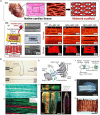Tissue Engineering and Regenerative Medicine: Achievements, Future, and Sustainability in Asia
- PMID: 32266221
- PMCID: PMC7105900
- DOI: 10.3389/fbioe.2020.00083
Tissue Engineering and Regenerative Medicine: Achievements, Future, and Sustainability in Asia
Abstract
Exploring innovative solutions to improve the healthcare of the aging and diseased population continues to be a global challenge. Among a number of strategies toward this goal, tissue engineering and regenerative medicine (TERM) has gradually evolved into a promising approach to meet future needs of patients. TERM has recently received increasing attention in Asia, as evidenced by the markedly increased number of researchers, publications, clinical trials, and translational products. This review aims to give a brief overview of TERM development in Asia over the last decade by highlighting some of the important advances in this field and featuring major achievements of representative research groups. The development of novel biomaterials and enabling technologies, identification of new cell sources, and applications of TERM in various tissues are briefly introduced. Finally, the achievement of TERM in Asia, including important publications, representative discoveries, clinical trials, and examples of commercial products will be introduced. Discussion on current limitations and future directions in this hot topic will also be provided.
Keywords: Asia; biomaterials; biomechanics; cell sources; regenerative medicine; tissue engineering.
Copyright © 2020 Han, Wang, Ding, Hu, Li, Yuan, Guo, Zhu, Yu, Wang, Zhao, Jia, Li, Yu, Zhang, Chu, Chen and Li.
Figures



References
-
- Alvarez K., Nakajima H. (2009). Metallic scaffolds for bone regeneration. Materials 2 790–832. 10.3390/ma2030790 - DOI
Publication types
LinkOut - more resources
Full Text Sources

